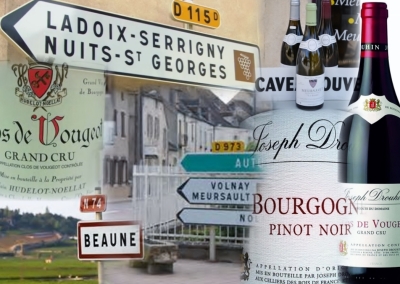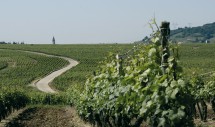One of the nicest short trips from Dijon is to follow Burgundy’s Côte d’Or region prized wine route. From north to south, this impeccable trail unveils the splendor of perfectly flanked vineyards: the Châtillonnais vineyards (about 20 villages producing red and white appellation wines); the vineyards of the Côte de Nuits (about 8 villages producing famous and robust burgundy red wines); situated on the slopes are the Hautes-Côtes de Nuits; the Côte de Beaune vineyards producing exquisite reds but also elegant white wines and further back the Hautes-Côtes de Beaune vineyards. Most of the vineyards of Côte d’Or face east or southeast and in autumn their leaves stir in the wind while glistening in fields of gold (continue below)…
The cultivation of wine can be traced back to antiquity. In particular, the skilled efforts of the Romans greatly influenced the viticulture development along their occupied territories including France. In Burgundy, it was the monks of Citeaux (called Cistercian; Cistercium the Latin name for the village of Cîteaux) who were responsible for elevating the Roman process of cultivating vines into an art form. These monks strictly followed the Rule of St Benedict (St Benedict of Nursia: c. 480 – 547) a book of precepts regarding the monastic life which also included the encouragement of manual labor and self-sufficiency. Thus the abbeys founded in Burgundy supported themselves through a variety of activities including viticulture. Gradually, the monks advanced their knowledge base by dedicating themselves to academic pursuits not only in agriculture but in research, science and medicine.
A celebrated and frequently visited vineyard along the wine route is the Clos de Vougeot (clos = walled-enclosed vineyard). Located in a beautiful setting its vines are a lasting example of the Cistercians’ work. Traditionally, the Benedictine monks of Cluny had already introduced to the region the subsequent grape varieties: Pinot Noir (for reds) and Chardonnay (for whites). However, these industrious viticulture experts discovered that there was a pronounced difference on the quality and tastes of the wine depending where the plant was sown, sometimes 200 meters could make a real difference. As such, they parceled the Clos de Vougeot vineyards accordingly. Of course, the geological variation of the soil is important. However, the orientation/exposure to the sun, rains, local climate alterations, slope, drainage, etc., are equally significant to the outcome of wine vintages. Hence, the concept of Terroir/soils in Burgundy is the main factor of designating a wine’s originality. Today, Clos de Vougeot is owned by an array of independent wine growers and the chateau is owned by the Société civile des Amis du Château du Clos de Vougeot (“Friends of the Château du Clos de Vougeot”), which leases its facilities to the Confrérie des Chevaliers du Tastevin. The Grand Cru appellation is bestowed upon this elegant wine which was honored by Isak Dinesen in her literary work “Babette’s Feast” due to its remarkably intense bouquet.
The wine road and villages between Dijon – Beaune may be visited by car, rental bicycles tours or by promenading its gentle hills. Each road sign along the way is a recollection of a fine wine list waiting to be revealed and tasted. For this reason, visitors are welcome to stop along the string of villages for wine tasting and purchases. Arriving in Beaune, which is considered the capital of burgundy’s wine, there are further opportunities for wine tastings in restaurants, commercial venues as well as wine-related institutes offering formal (certification) and informal classes. A historical landmark worth visiting in Beaune is the Hospices de Beaune or Hôtel-Dieu de Beaune. The Hospices were founded as a charitable hospital in 1443 by Nicolas Rolin, chancellor of Burgundy, and his wife. Its architecture represents the 15th century style well. Of particular significance, since 1851 every year around November, the Hospices hold a classical and influential charitable wine-auction devoted to the food and wines of Burgundy. It is a worthwhile social and cultural experience!
After an eventful exploration of the region, I highly recommend visiting the picturesque village of Meursault. Located on the Côte of Beaune, these fine white wines vineyards are exclusively cultivated from Chardonnay grapes. While exploring the village, stop by the office of tourism and they will help you rent bikes and even secure a place on a hot air balloon ride of the region. This is a beautiful area and I highly recommend staying at La Cueillette Hotel & Spa. This lovely 19th century château was built on the foundations of a 12th century Cistercian residence within walled vineyard parcels allowing for pleasant promenades through nature. At the Spa you can reward yourself by plunging into the whirlpool and swimming pool. For a total body relaxation, I recommend their sauna followed by their “Frutithérapie” exfoliating massage with red berries pulp, honey and grape seed oil. Certainly, all of their well-being beauty products make great souvenirs to take home. The Château de Cîteaux also provides fine dining with an exquisite ambiance. If you cannot stay long at La Cueillette, I recommend at least paying a visit to their Sunday brunch which is a memorable banquet that you can share with friends and family during the warm summer months. Their ample veranda is a most favorable place for such fetching celebration and for building lasting memories.




























